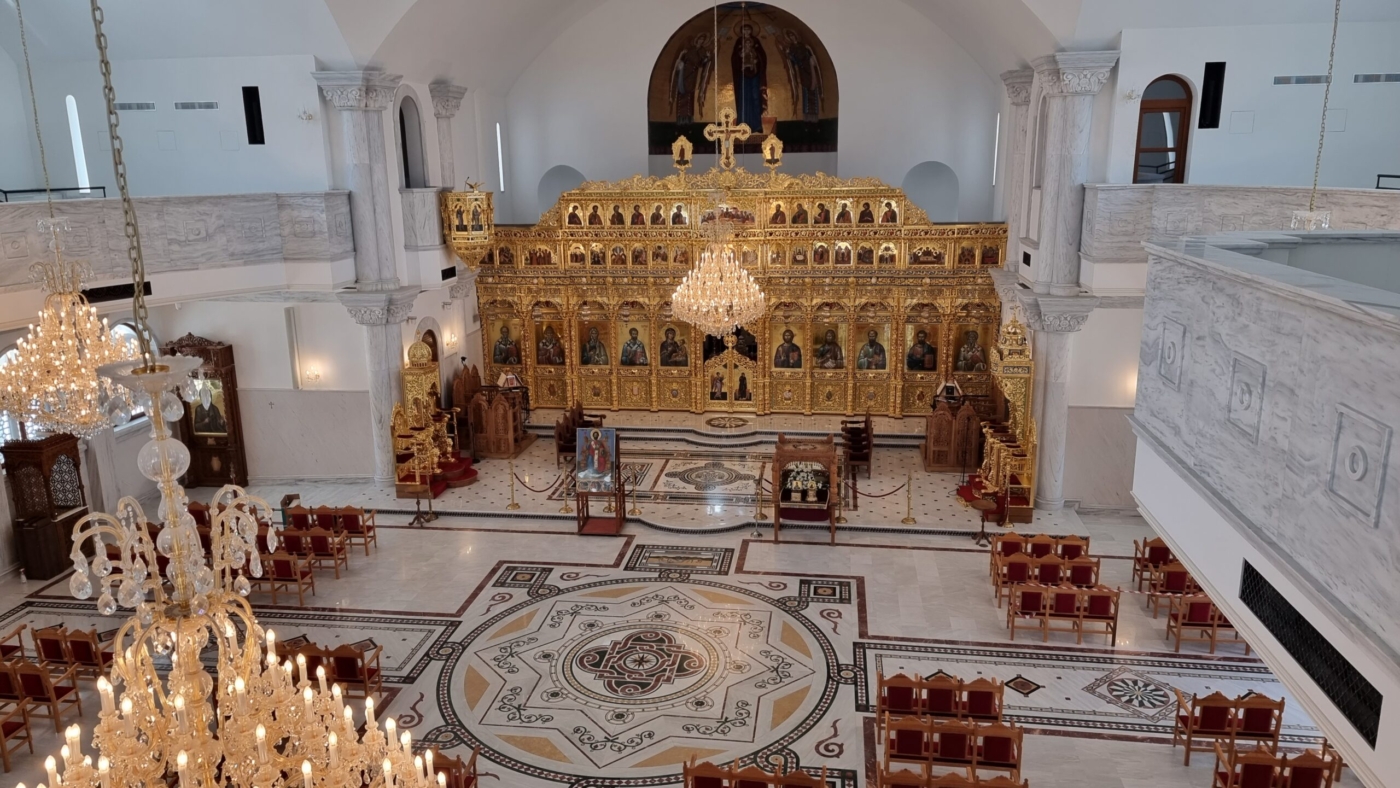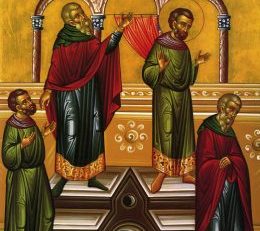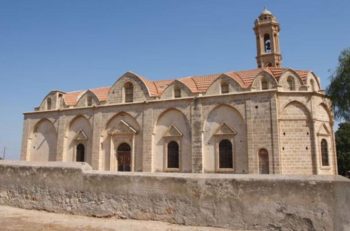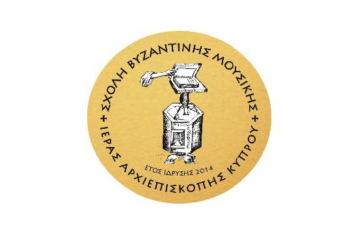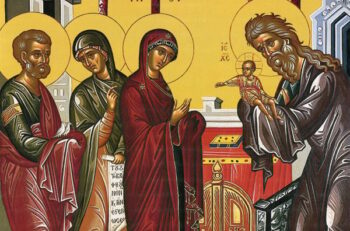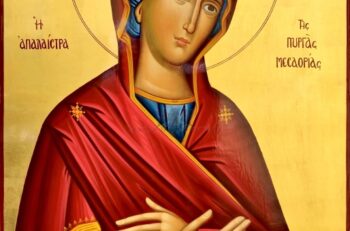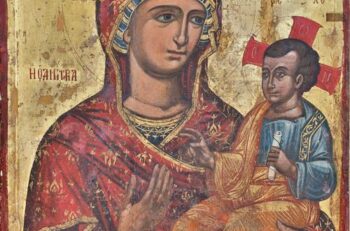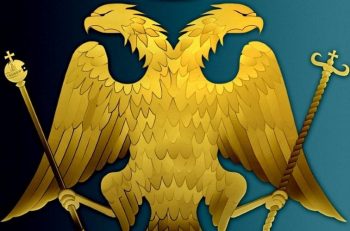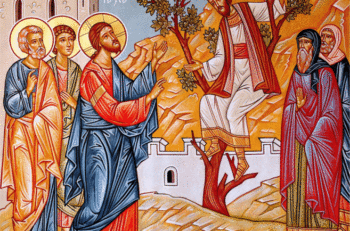Καθεδρικός Ναός Αποστόλου Βαρνάβα
Πανηγυρίζει τὴν 11ην Ἰουνίου.
Ἐφημέριοι: Πρωτ. Δημήτριος Δημοσθένους (τηλ.: 99618763) καὶ Πρωτ. Κυπριανὸς Κουντούρης (τηλ.: 99790750).
Διάκονος: Μιχαὴλ Νικολάου (τηλ.: 99801685).
Ψάλται: Ἀνδρέας Κουκκίδης, Μάριος Κουκκίδης καὶ Χαράλαμπος Παπαγεωργίου.
Ἐπίτροποι: Πρωτ. Δημήτριος Δημοσθένους, Στέλιος Στυλιανοῦ, Κωνσταντῖνος Κωνσταντίνου, Ἠλίας Ζήρας καὶ Παῦλος Χατζηπαύλου.
*****************************
ΚΑΘΕΔΡΙΚΟΣ ΝΑΟΣ ΑΠΟΣΤΟΛΟΥ ΒΑΡΝΑΒΑ
————–
Ὁ Καθεδρικὸς Ναὸς τοῦ Ἀποστόλου Βαρνάβα εἶναι νεόδμητος ναός, ὁ ὁποῖος ἄρχισε νὰ κτίζεται τὸ 2019 καὶ περατώθηκε τὸ 2021. Ἀποτελεῖται κυρίως ἀπὸ ὁπλισμένο σκυρόδεμα μὲ ἐπένδυση, ἐξωτερικὰ πέτρας καὶ ἐσωτερικὰ μαρμάρων. Τὰ ἐγκαίνια τοῦ ναοῦ ἔγιναν στὶς 11 Ἰουνίου 2021,[1] ἡμέρα κατὰ τὴν ὁποία ἑορτάζει ὁ ἀπόστολος Βαρνάβας, ἱδρυτὴς καὶ προστάτης τῆς Ἐκκλησίας Κύπρου.
Ἀπὸ τὰ παλαιοχριστιανικὰ χρόνια (4ος αἰ. καὶ ἑξῆς) ἀπαντοῦν μεγαλοπρεπεῖς ναοὶ σὲ μεγάλες πόλεις, οἱ ὁποῖοι πιθανῶς εἶχαν λειτουργικότητα καθεδρικοῦ ναοῦ, ὅπως ἡ βασιλικὴ τῆς Χρυσοπολίτισσας στὴν Πάφο (πρωτεύουσα κατὰ τὴ ρωμαϊκὴ περίοδο) καὶ ἡ βασιλικὴ τοῦ ἁγίου Ἐπιφανίου στὴν Σαλαμῖνα/Κωνσταντία (πρωτεύουσα καὶ ἀρχιεπισκοπὴ κατὰ τὴν πρώιμη καὶ μέση βυζαντινὴ περίοδο). Κατὰ τὴ μεταφορὰ τῆς πρωτεύουσας ἀπὸ τὴν Κωνσταντία στὴ Λευκωσία (πιθ. 10ος αἰ.) ἀπὸ τοὺς βυζαντινοὺς ἡγεμόνες, ἔγιναν προσπάθειες δημιουργίας καθεδρικοῦ ναοῦ, ἀντάξιου τοῦ κύρους τῆς Αὐτοκεφάλου Ἐκκλησίας τῆς Κύπρου, οἱ ὁποῖες, ὅμως, φαίνεται ὅτι δὲν ἐτελεσφόρησαν, λόγῳ τῶν ἀλλεπάλληλων ἐπιδρομῶν καὶ κατακτήσεων στὸ νησί.[2]
Στὴ βάση τοῦ ναοῦ τῆς Ἁγίας Σοφίας (σημερινοῦ τεμένους Σελιμιγιέ), στὴν κατεχόμενη ὑπὸ τῶν τουρκικῶν στρατευμάτων περιοχὴ τῆς παλιᾶς Λευκωσίας, πλησίον τοῦ καθεδρικοῦ τοῦ Ἀπ. Βαρνάβα, βρίσκονται τὰ θεμέλια τοῦ ὀρθόδοξου ναοῦ τῆς τοῦ Θεοῦ Σοφίας. Αὐτὸ τὸ κτῖσμα χρησιμοποίησαν ὡς βάση οἱ Φράγκοι κατακτητές, ἀφοῦ πρῶτα κατεδάφισαν τὸν βυζαντινὸ τρουλλαῖο ναό, γιὰ νὰ ἀνεγείρουν τὸν μεγαλοπρεπῆ λατινικὸ ναό (μεταξὺ 1209-1326), γοτθικῆς ἀρχιτεκτονικῆς, διατηρώντας τὴ βυζαντινὴ ὀνομασία του.
Δίπλα ἀπὸ τὴν Ἁγ. Σοφία/Selimiye σώζεται τὸ ὀθωμανικὸ Bedestan (Ἀγορά), στὴ θέση ἀρχικῶς παλαιοχριστιανικῆς βασιλικῆς (ὑπάρχουν ἐντὸς τμήματα τῶν παλαιοχριστιανικῶν ἁψίδων της), καὶ κατόπιν βυζαντινοῦ ναοῦ, ὅπου τοποθετεῖται κεντρικὸς ναὸς τῶν Ὀρθοδόξων ἐπὶ Φραγκοκρατίας[3] καὶ Ἑνετοκρατίας, ἀφιερωμένος στὴν Παναγία Ὁδηγήτρια. Ὁ ναὸς αὐτὸς κατὰ τὴν Ἀγγλοκρατία εἶναι γνωστὸς καὶ ὡς Ἅγιος Νικόλαος (τῶν Ἄγγλων). Στὴν πρώιμη Τουρκοκρατία φέρεται ὡς ἀρχιεπισκοπικὸς ναὸς ὁ σωζόμενος, μεσαιωνικὸς Ἀρχάγγελος Μιχαὴλ «Τρυπιώτης». Τέλος, κοντὰ καὶ στὸ Ἀρχιεπισκοπικὸ Μέγαρο βρίσκεται ναός, ἀφιερωμένος στὸν ἅγιο Ἰωάννη τὸν Θεολόγο, τὸν Πίπη (=Bibi, συριακὰ ὁ Ἠγαπημένος), κτισμένος ἀρχικὰ τὸν 11ο αἰ. ὡς καθολικὸ Μονῆς, ποὺ μετασκευάστηκε στὴ σημερινή του μορφὴ μεταξὺ 1662-1674 καὶ ἀπὸ τὸ 1730 περίπου μετατράπηκε σὲ καθεδρικὸ ναὸ τῆς Ἀρχιεπισκοπῆς Κύπρου καὶ λειτούργησε ἔτσι ἕως τὸ 2021.
Μὲ αὐτὸ τὸ ἱστορικὸ ὅραμα, ὁ μακαριστὸς ἀρχιεπίσκοπος Κύπρου Χρυσόστομος Β΄ ἔθεσε ἀνάμεσα στοὺς στόχους τῆς ἀρχιεπισκοπείας του τὴ διοικητικὴ καὶ πνευματικὴ ἀνασυγκρότηση τῆς Ἐκκλησίας, καὶ τὴν ἀνοικοδόμηση περικαλλοῦς ναοῦ, γιὰ νὰ ἐξυπηρετεῖ τὶς σημερινὲς ἀνάγκες τῆς Αὐτοκέφαλης Ἐκκλησίας, τὶς τελετὲς καὶ ἐκδηλώσεις τῆς Ἐκκλησίας Κύπρου. Γιὰ αὐτὸ τὸν λόγο ὁ ναὸς ἀφιερώθηκε στὸν ἱδρυτὴ καὶ προστάτη τῆς Ἐκκλησίας τῆς Κύπρου, Ἀπόστολο Βαρνάβα.[4]
Ὁ ναὸς ἐντάσσεται στὸν ἀρχιτεκτονικὸ τύπο τοῦ σταυροειδοῦς ἐγγεγραμμένου μὲ τροῦλλο, ἐνῶ μία ἀπὸ τὶς ἰδιαιτερότητές του εἶναι ὅτι στὸ ἐσωτερικὸ μέρος του δὲν διαθέτει κολῶνες (μονόχωρος μὲ στοιχεῖα περίκεντρου). Ἔτσι ἀπὸ ὅλα τὰ σημεῖα τοῦ ναοῦ[5] ὁ πιστὸς ἔχει ὀπτικὴ ἐπαφὴ μὲ τὸ Ἱερὸ Βῆμα, ὅπου τελεῖται ἡ θεία Εὐχαριστία, καθὼς καὶ μὲ τὸν ἐπιβλητικὸ Παντοκράτορα, ὁ ὁποῖος ἱστορήθηκε μὲ ψηφῖδες στὸν τροῦλλο, διαμέτρου 14 μέτρων.
Τὸ πρότυπο γιὰ τὴ δημιουργία τῆς μορφῆς τοῦ Παντοκράτορα εἶναι ἡ τοιχογραφία τοῦ τρούλλου τῆς Παναγίας τοῦ Ἄρακα στὰ Λαγουδερά. Ὁ Παντοκράτορας περιστοιχίζεται ἀπὸ ἀγγέλους σὲ μετάλλια καὶ πιὸ κάτω ἀπὸ Προφῆτες τῆς Παλαιᾶς Διαθήκης. Στὰ ὑαλογραφήματα (βιτρώ). Ἐνδιάμεσα τῶν Προφητῶν, ἱστοροῦνται οἱ Δώδεκα Ἀπόστολοι καὶ στὸ κέντρο ἡ «Ἑτοιμασία τοῦ Θρόνου». Δεξιὰ καὶ ἀριστερὰ σὲ στάση δέησης βρίσκονται ἡ Παναγία καὶ ὁ Ἰωάννης ὁ Πρόδρομος.
Ἡ κόγχη τοῦ Ἱεροῦ Βήματος κοσμεῖται μὲ ψηφιδωτὸ τῆς ὄρθιας Θεοτόκου Βρεφοκρατούσης (Βλαχερνίτισσας), ἀντιγραφὴ τοῦ ψηφιδωτοῦ (9ος αἰ.) ἀπὸ τὸν ναὸ τῆς Κοιμήσεως τῆς Θεοτόκου στὴ Νίκαια τῆς Βιθυνίας (Μικρὰ Ἀσία). Οἱ ἄγγελοι ἀποτελοῦν προσθήκη στὸ ἀρχικὸ πρότυπο. Ὁ ναὸς ὅπου βρισκόταν τὸ ψηφιδωτὸ καταστράφηκε μαζὶ μὲ τὴ ψηφιδωτὴ παράσταση, ἀπὸ τοὺς Τούρκους κατὰ τὴ Μικρασιατικὴ Καταστροφὴ τοῦ 1922.
Τὸ εἰκονοστάσιο τοῦ ναοῦ εἶναι ξυλόγλυπτο, ἐπιχρυσωμένο καὶ οἱ φορητὲς εἰκόνες του περιλαμβάνουν ἁγίους, οἱ ὁποῖοι ἔχουν ἄμεση σχέση μὲ τὴν Κύπρο. Ἱστοροῦνται βάσει τῆς τεχνοτροπίας τῆς Μακεδονικῆς σχολῆς (14ος αἰ.). Ἡ εἰκόνα τῆς Θεοτόκου ἀντιγράφει τὴν Παναγία τὴν Ἐγκλειστριανή (16ος αἰ.),[6] ἡ ὁποία θησαυρίζεται στὴ Μονὴ τοῦ ἁγίου Νεοφύτου στὴν Πάφο, μονή μετανοίας τοῦ μακαριστοῦ ἀρχιεπισκόπου Χρυσοστόμου Β΄.
Ἀκολούθως πρὸς τὰ ἀριστερὰ ἀπαντοῦν οἱ:
Ἀπόστολος Ἰωάννης, ὁ Θεολόγος, ὁ ὁποῖος εἶναι ὁ ἠγαπημένος μαθητὴς τοῦ Χριστοῦ καὶ συγγραφέας τοῦ τετάρτου εὐαγγελίου. Ἡ συνήθεια νὰ ἱστορεῖται δίπλα ἀπὸ τὴ Θεοτόκο ἀφορᾶ σὲ τοπικὴ παράδοση τῆς Κύπρου,[7] ἐνῶ στὸν ὑπόλοιπο ὀρθόδοξο κόσμο συνηθίζεται ἀριστερὰ τῆς εἰκόνας τῆς Θεοτόκου, νὰ βρίσκεται ἡ εἰκόνα τοῦ ἁγίου, στὸν ὁποῖο εἶναι ἀφιερωμένος ὁ ναός. Στὸν νέο Καθεδρικό, ἀκολουθώντας τὴν τοπικὴ παράδοση, ἡ εἰκόνα τοῦ ἁγίου τοῦ ναοῦ βρίσκεται στὸ νότιο ἄκρο τοῦ εἰκονοστασίου.
Ὁ Ἀπόστολος Ἀνδρέας, τὸν ὁποῖο ἡ παράδοση θέλει νὰ ἔχει ναυαγήσει στὸ ἀνατολικότερο ἄκρο τοῦ νησιοῦ, ἐκεῖ ὅπου σήμερα βρίσκεται τὸ μοναστήρι του, τὸ ὁποῖο τελεῖ ὑπὸ τουρκικὴ κατοχή.
Ὁ Ἀρχάγγελος Μιχαήλ, ὁ ὁποῖος ὡς Ἀρχιστράτηγος τῶν ἀγγελικῶν δυνάμεων, συνηθίζεται νὰ ἱστορεῖται στὴ βόρεια θύρα τοῦ ἱεροῦ Βήματος, ὡς φύλακας τοῦ Ἱεροῦ Βήματος.
Ὁ Ἅγιος Σπυρίδων, ἐπίσκοπος Τριμυθοῦντος τῆς Κύπρου συμμετεῖχε στὴν Α΄ Οἰκουμενικὴ Σύνοδο, στὴ Νίκαια τὸ 325 μ.Χ.
Ὁ Ἅγιος Ἐπιφάνιος, (ἀρχι)ἐπίσκοπος Κύπρου, ὁ ὁποῖος εἶναι ἕνας ἀπὸ τοὺς μεγάλους Πατέρες τοῦ 4ου αἰώνα καὶ ἀπὸ τοὺς θεολογικότερους καὶ πολυγραφότερους ἱεράρχες τῆς Κύπρου. Ἤδη ἀπὸ τὸν 6ο αἰ. εἰκονογραφεῖται συχνὰ μὲ τὸν ἀπόστολο Βαρνάβα.
Μετὰ τὴν εἰκόνα τοῦ Χριστοῦ στὰ δεξιὰ τοῦ τέμπλου ἀπαντοῦν οἱ:
Ὁ Ἰωάννης ὁ Πρόδρομος, ὁ ὁποῖος βρίσκεται πάντοτε δίπλα στὸν Χριστό, ὡς ὁ Πρόδρομος καὶ Βαπτιστής Του.
Οἱ Ἀπόστολοι Παῦλος καὶ Μᾶρκος, οἱ ὁποῖοι ἦλθαν στὴν Κύπρο μὲ τὸν Ἀπόστολο Βαρνάβα γιὰ νὰ κηρύξουν τὸ εὐαγγέλιο.
Ὁ Ἅγιος Τριφύλλιος, ἐπίσκοπος Λήδρας (Λευκωσίας) καὶ πολιοῦχος τῆς πόλης, ὁ ὁποῖος ὑπῆρξε μαθητὴς τοῦ ἁγίου Σπυρίδωνος.
Ἀπόστολος Βαρνάβας, ὁ ὁποῖος ἀναφέρεται στὴν Καινὴ Διαθήκη, στὸ βιβλίο τῶν Πράξεων τῶν Ἀποστόλων, ὡς ἕνας ἀπὸ τοὺς ἑβδομήκοντα μαθητὲς τοῦ Χριστοῦ. Τὸ ὄνομά του σημαίνει «υἱὸς παρακλήσεως», γι’ αὐτὸ στὸ βιβλίο τῶν Πράξεων τῶν Ἀποστόλων κατέχει ἡγετικὸ ρόλο στὴν πρώτη χριστιανικὴ κοινότητα. Ὁ Ἀπόστολος Βαρνάβας ἐγγυᾶται – «χειραγωγεῖ» τὸν Παῦλο στοὺς κορυφαίους τῶν Ἀποστόλων, ὡς ἰσάξιο ἀπόστολο μὲ τοὺς ὑπόλοιπους. Ὁ Βαρνάβας μὲ τοὺς Παῦλο καὶ Μᾶρκο ἔρχονται στὴν Κύπρο, ὅπου κηρύσσουν τὸ εὐαγγέλιο τοῦ Χριστοῦ κατὰ τὴν πρώτη ἀποστολικὴ περιοδεία(45/46 μ.Χ.).[8]
Στὸ ἄνω διάζωμα τοῦ εἰκονοστασίου διακρίνεται τὸ Δωδεκάορτο, δηλαδὴ οἱ εἰκόνες μὲ τὶς πιὸ σημαντικὲς ἑορτὲς τοῦ Χριστολογικοῦ καὶ Θεομητορικοῦ κύκλου, οἱ ὁποῖες ἔχουν σχέση μὲ τὴ ζωὴ τῆς Ὀρθόδοξης Ἐκκλησίας. Τὰ πρότυπα τῆς συγκεκριμένης ἀπεικόνισης εἶναι ἔργα τοῦ Θεοφάνη τοῦ Κρητὸς (16ος αἰ.) καὶ κοσμοῦν μονὲς τοῦ Ἁγίου Ὄρους. Στὸ ψηλότερο διάζωμα ἀπαντοῦν οἱ Δώδεκα Ἀπόστολοι, ἀντιγραφὴ ἀπὸ τὸ εἰκονοστάσιο τοῦ νέου Καθολικοῦ τῆς Μονῆς Ἁγίου Νεοφύτου στὴν Πάφο (16ος αἰ.).
Τὸ ξυλόγλυπτο τέμπλο καὶ ἡ Ἁγία Τράπεζα[9] εἶναι ἔργο τῶν ἀδελφῶν Ἀγριδιώτη, οἱ ἐπιχρυσώσεις καὶ τὰ διακοσμητικὰ σύμβολα ἔγιναν ἀπὸ τὸν μοναχὸ Δομέτιο καὶ τοὺς συνεργάτες του. Οἱ εἰκόνες τοῦ τέμπλου, τοῦ ἄμβωνος, τῶν προσκυνηταρίων καὶ τῆς Ἁγίας Τραπέζης εἶναι ἔργα τῶν Ἀδάμου Ἀδάμου, Μάριου καὶ Γεωργίου Σταυρινοῦ. Τὰ κανδήλια, σὲ σχῆμα τριγωνικό, ἀποτελοῦν μίμηση τῶν ἀντίστοιχων τοῦ παλαιοῦ Καθεδρικοῦ τοῦ Ἁγίου Ἰωάννου, καὶ φιλοτεχνήθηκαν μαζὶ μὲ τὴν ἑπτάφωτο λυχνία ἀπὸ τὸν ἀργυροχόο Μιχαὴλ Σιάλο. Ἀντιγράφουν ἀντίστοιχα κανδήλια κυπριακῶν ἐργαστηρίων τοῦ 19ου καὶ 20οῦ αἰ.
Τὸ περίτεχνο Ἀρτοφόριο, τὸ ὁποῖο ἀποτελεῖ μικρογραφία τοῦ ναοῦ (στὸν ἀρχικό του σχεδιασμό), τὰ ἑξαπτέρυγα καθὼς καὶ τὸ κάλυμμα τοῦ μεγάλου χειρογράφου εὐαγγελίου εἶναι ἔργο τοῦ ἐργαστηρίου τοῦ Ἠλία Νούση. Τὸ μεγάλο χειρόγραφο εὐαγγέλιο (75x56cm), εἶναι γραμμένο μὲ σινικὴ μελάνη καὶ εἰκονογραφημένο κατὰ τὸν τύπο τῶν παλαιῶν χειρογράφων, μὲ 540 στῆλες, ἀπὸ τὸν πρωτοπρεσβύτερο Δημοσθένη Δημοσθένους. Στὴν μπροστινὴ ὄψη τοῦ καλύμματος τοῦ εὐαγγελίου δεσπόζει χαραγμένη ἡ Ἀνάσταση καὶ ἀπεικονίζονται 12 μορφὲς Ἀποστόλων, μὲ προεξάρχουσα τὴν μορφὴ τοῦ ἀποστόλου Βαρνάβα, ἐνῶ στὴν πίσω ὄψη εἶναι χαραγμένη ἡ Σταύρωση καὶ ἀπεικονίζονται 12 μορφὲς ἁγίων ἐπισκόπων τῆς Κύπρου.
Τὰ ψηφιδωτὰ καὶ τὰ ὑελογραφήματα (βιτρώ) εἶναι κατασκευασμένα στὴ Ρουμανία (ἐργ. Art Georgies, Ἰάσιο). Τὸν συντονισμὸ εὕρεσης τῶν εἰκονογραφικῶν προτύπων τῶν ψηφιδωτῶν ἀνέλαβε ὁ μητροπολίτης Κωνσταντίας Βασίλειος. Οἱ πολυέλαιοι εἶναι κατασκευασμένοι στὴν Τσεχία, οἱ καμπάνες στὴν Πολωνία, οἱ μαρμάρινες διακοσμήσεις καὶ τὰ πατώματα στὴν Ἑλλάδα. Τὸν ἀρχιτεκτονικὸ σχεδιασμὸ καὶ ἐπιμέλεια εἶχε ὁ Νῖκος Μελετίου.
Στὸ νότιο μέρος τοῦ περιβόλου τοῦ ναοῦ ὑπάρχουν σπαράγματα ἀρχαιολογικῶν εὑρημάτων δεδομένου ὅτι βρισκόμαστε στὸν πυρῆνα τῆς μεσαιωνικῆς Λευκωσίας, ὅπως ἔδειξαν οἱ ἀνασκαφὲς στὸν χῶρο μεταξὺ Ἀρχιεπισκοπῆς, Παλαιοῦ καὶ Νέου Δημαρχείου. Μεταξὺ ἄλλων ἐπισημάνθηκαν θεμέλια δύο ἐρειπωμένων βυζαντινῶν ναΐσκων. Τὰ συγκεκριμένα σπαράγματα στὸν περίβολο τοῦ ναοῦ εἶναι ἀπὸ τὴ μεσαιωνικὴ (κιν)στέρνα (δεξαμενή), ἡ ὁποία πιθανῶς ἀνῆκε στὴν προγενέστερη Μονὴ τοῦ Ἁγίου Ἰωάννου τοῦ Θεολόγου.
Ἐξωτερικά, πάνω ἀπὸ τὴ βόρεια εἴσοδο βρίσκεται ψηφιδωτὴ ἀναθηματικὴ ἐπιγραφὴ μὲ πληροφορίες γιὰ τὸν ἐγκαινισμὸ τοῦ ναοῦ. Ὁ Ναὸς διαθέτει τέσσερα ἐνσωματωμένα καμπαναριά, ἐνῶ στὸν περίβολό του δημιουργήθηκε ὑπερυψωμένη ἐξέδρα γιὰ τὶς ἀνάγκες τῶν διάφορων ἐκδηλώσεων.
Μὲ τὴ δημιουργία τῆς μεγάλης πλατείας μεταξὺ τοῦ Καθεδρικοῦ καὶ τοῦ νέου Δημοτικοῦ Μεγάρου, καθὼς καὶ τὴν ὕπαρξη πέριξ αὐτῆς Μουσείων, ὅπως τὸ Βυζαντινό, Λαϊκῆς Τέχνης, τῶν Μουσείων τοῦ Παγκυπρίου Γυμνασίου, τοῦ Ἀρχοντικοῦ τοῦ Χατζηγεωργάκη Κορνέσιου, τῆς Ἱερᾶς Ἀρχιεπισκοπῆς καὶ τοῦ Παγκυπρίου Γυμνασίου, δημιουργεῖται ἕνας νέος πολιτιστικὸς πυρήνας στὸ κέντρο τῆς πόλης τῆς Λευκωσίας.
[1] Ὁ θεμέλιος λίθος τέθηκε 11 Ἰουνίου 2016 ἐνῶ τὰ Θυρανοίξια τοῦ Ναοῦ ἔγιναν κατὰ τὸν ἑσπερινὸ τῆς Κυριακῆς τῶν Βαΐων 24 Ἀπριλίου 2021 (Σάββατο τοῦ Λαζάρου 2021).
[2] Ἡ κυριαρχία τῶν (ὀρθόδοξων) χριστιανῶν Ἑλλήνων τῆς Ἀνατολικῆς Ρωμαϊκῆς Αὐτοκρατορίας (Βυζαντινῆς) τερματίζεται τὸ 1191, μὲ τὴν κατάληψη τῆς Κύπρου ἀπὸ τὸν Ριχάρδο τὸν Λεοντόκαρδο, ὁ ὁποῖος λίγο ἀργότερα τὴν πούλησε στοὺς Ναΐτες Ἱππότες, οἱ ὁποῖοι τὴν ἐπέστρεψαν στὸν Ριχάρδο καὶ αὐτὸς τὴν πούλησε ἐκ νέου στὸν γάλλο εὐγενῆ Γκὺ τῶν Λουζινιάν, ἐγκαινιάζοντας τὴν περίοδο τῆς Φραγκοκρατίας (1192-1489), στὴν ὁποία περιλαμβάνονται ἐπιδρομὲς Γενουατῶν (1374) καὶ Σαρακηνῶν (1426). Ἀκολουθεῖ ἡ Ἑνετοκρατία (1489-1570), ἡ Τουρκοκρατία (1570-1878) καὶ ἡ Βρεττανικὴ Ἀποικιοκρατία (1878-1960).
[3] Κατ’ αὐτὴν τὴν περίοδον καταργεῖται μὲ τὴ Bulla Cypria (1260) τοῦ Πάπα Ἀλεξάνδρου Δ΄ ἡ ἕδρα τοῦ ὀρθόδοξου Ἀρχιεπισκόπου. Καθ’ ὅλο τὸ διάστημα τῆς Φραγκοκρατίας καὶ Ἑνετοκρατίας δὲν ὑπάρχει ὀρθόδοξος Ἀρχιεπίσκοπος. Ἡ ἕδρα τοῦ Ἀρχιεπισκόπου ἀνασυστάθηκε τὸ 1571, μετὰ τὴν πλήρη κατάληψη τῆς Κύπρου ἀπὸ τοὺς Ὀθωμανοὺς Τούρκους.
[4] Ἔγιναν ἀξιόλογες προσπάθειες γιὰ ἀνοικοδόμηση ναοῦ ἀνταποκρινόμενου στὶς ἀνάγκες τῆς Ἱερᾶς Ἀρχιεπισκοπῆς, κυρίως μετὰ τὴν ἀνεξαρτησία (1960), ὅπως οἱ ναοὶ τῆς Παναγίας τῆς Παλλουριώτισσας καὶ τῆς τοῦ Θεοῦ Σοφίας στὸν Στρόβολο (2008).
[5] Ἐσωτερικὰ τοῦ Ναοῦ στὸ ἄνω ἐπίπεδο ὑπάρχουν 3 ἐξώστες (γυναικωνίτης), οἱ ὁποῖοι ἔχουν σχεδιαστεῖ μὲ καμπύλη πρόσοψη ἔχοντας ὑπόψιν καὶ τὴν ἀπρόσκοπτη θέα ἀπὸ τὴ στιγμὴ εἰσόδου στὸν Ναό (δυτικά, βόρεια καὶ νότια).
[6] Ἡ Παναγία ἡ Ἐγκλειστριανὴ φέρεται ὡς δῶρο τοῦ ἡγούμενου τῆς Μονῆς τοῦ Ἁγίου Νεοφύτου στὸ καθολικὸ τῆς Μονῆς καὶ ὑπογράφεται ἀπὸ τὸν ζωγράφο Θεοφύλακτο.
[7] Ἴσως αὐτὴ ἡ παράδοση νὰ ἔχει τὶς ρίζες της στὸ λόγο τοῦ Χριστοῦ στὸν Σταυρό πρὸς τὴν Θεοτόκο καὶ τὸν Ἰωάννη, ὅπου τοὺς καλεῖ μητέρα καὶ υἱὸ ἀντίστοιχα. Πιθανῶς δὲ νὰ ἐμφορεῖται καὶ ἀπὸ τὶς σχέσεις τῆς Κύπρου μὲ τὴν Πάτμο (πιθ. Ἐφραὶμ Ἀθηναῖο, Σχολάρχη τοῦ Ἑλληνομουσείου τοῦ σημερινοῦ Παγκυπρίου Γυμνασίου) καὶ τὴν εἰκονογράφηση σκηνῶν τῆς Ἀποκάλυψης στὸν παλαιὸ Καθεδρικὸ τοῦ ἁγίου Ἰωάννου.
[8] Κατὰ τὴν πρώτη ἀποστολικὴ περιοδεία ὁ Ἀπόστολος Βαρνάβας μαζὶ μὲ τὸν Παῦλο καὶ τὸν ἀνεψιό του Μᾶρκο φθάνουν στὴν Κύπρο καὶ ἀποβιβάζονται στὴ Σαλαμῖνα. Ἀκολούθως περνοῦν ἀπὸ τὴ Λάρνακα, ὅπου ἐγκαθιστοῦν τὸν Λάζαρο, τὸν ὁποῖον ἀνέστησε ὁ Χριστὸς μετὰ ἀπὸ τέσσερις ἡμέρες στὸν τάφο, ὡς πρῶτο ἐπίσκοπο Κιτίου (Λάρνακας). Ἀκολούθως διέρχονται ἀπὸ τὴν ἐνδοχώρα, ἀπὸ τὰ βουνὰ τοῦ Τροόδους καὶ καταλήγουν στὴν Πάφο, ὅπου κατηχοῦν τὸν Ρωμαῖο ἀνθύπατο Σέργιο Παῦλο. Σὲ αὐτὴ τὴν κατήχηση ἀντιστέκεται Ἐλύμας ὁ μάγος, ὁ ὁποῖος τυφλώνεται. Ἀκολούθως οἱ Ἀπόστολοι φεύγουν ἀπὸ τὸ νησί, γιὰ νὰ ἐπιστρέψει ἀργότερα μόνος ὁ Βαρνάβας καὶ νὰ συνεχίσει τὸ ἔργο τοῦ εὐαγγελισμοῦ τῶν συμπατριωτῶν του. Τὸ 57 μ.Χ. βρίσκει μαρτυρικὸ θάνατο στὴ Σαλαμῖνα, ὅπου καὶ ἐνταφιάζεται.
Γιὰ τὴν Ὀρθόδοξη Ἐκκλησία τῆς Κύπρου θεωρεῖται ὁ Ἱδρυτὴς καὶ Προστάτης της, ἐφόσον σὲ αὐτὸν ὀφείλεται ἡ Αὐτοκεφαλία της. Τὸ Αὐτοκέφαλον τῆς Ἐκκλησίας Κύπρου δόθηκε ἀπὸ τὴν Γ΄ Οἰκουμενικὴ Σύνοδο τὸ 431. Ἐξαιτίας τῆς ἀντίθεσης τῆς Ἐκκλησίας τῆς Ἀντιόχειας, τὸ Αὐτοκέφαλο τῆς Ἐκκλησίας τῆς Κύπρου ἐπικυρώθηκε μὲ αὐτοκρατορικὴ σφραγῖδα, ἀπὸ τὸν αὐτοκράτορα Ζήνωνα (473-491). Ὁ τότε ἀρχιεπίσκοπος Κύπρου Ἀνθέμιος βλέπει σὲ ὅραμα τὸν Ἀπόστολο Βαρνάβα, ὁ ὁποῖος τοῦ ὑποδεικνύει τὸ σημεῖο ὅπου βρισκόταν θαμμένο τὸ σκήνωμά του. Ὁ Ἀνθέμιος ἀνακαλύπτει τὸ σῶμα τοῦ Ἀποστόλου καὶ στὸ στῆθος του χειρόγραφο εὐαγγέλιο τοῦ ἀποστόλου Ματθαίου. Ἀκολούθως μεταβαίνει στὴν Κ/πολη, ὅπου δωρίζει τὸ εὐαγγέλιο στὸν αὐτοκράτορα Ζήνωνα, μὲ αἴτημα τὴν ἐπικύρωση τοῦ Αὐτοκέφαλου τῆς Ἐκκλησίας τῆς Κύπρου. Ὁ αὐτοκράτορας Ζήνων, ἐπικυρώνοντας τὴν ἀπόφαση τῆς Γ΄ Οἰκουμενικῆς, δίδει, κατὰ τὴν παράδοση, στὸν ἀρχιεπίσκοπο Κύπρου τρία αὐτοκρατορικὰ προνόμια, δηλαδὴ νὰ φορεῖ πορφυρὸ μανδύα στὶς ἀκολουθίες, νὰ κρατεῖ τὸ αὐτοκρατορικὸ σκῆπτρο, ἀντὶ ποιμαντορικῆς ράβδου καὶ νὰ ὑπογράφει μὲ κιννάβαρη (κόκκινη μελάνη).
[9] Κατασκευάστηκε ἀπὸ τὰ τρία ξύλα, τὰ ὁποῖα κατὰ τὴν παράδοση συνέθεταν τὸν Σταυρὸ τοῦ Κυρίου (πεῦκο, κυπάρισσο καὶ κέδρο). Κάτω ἀπὸ τὶς μεγάλες φορητὲς εἰκόνες καθὼς καὶ στὸ μαρμάρινο πάτωμα ἀποτυπώνονται διάφορα [πρωτο]χριστιανικὰ σύμβολα, ὅπως ὁ ἰχθύς, ἡ ἔλαφος, , ὁ ταώς (παγώνι), ὁ πελεκάνος, ὁ δικέφαλος ἀετὸς κτλ.
*****************************
THE CATHEDRAL OF THE APOSTLE BARNABAS
The Cathedral of Apostle Barnabas is a newly built church, which began construction in 2019 and was completed in 2021. It consists mainly of reinforced concrete with cladding, stone exterior and marble interior. The inauguration of the church took place on 11 June 2021, the day on which the Apostle Barnabas, founder and patron of the Church of Cyprus, is celebrated.
During the transfer of the capital from Constantia to Nicosia (ca. 10th century) by the Byzantine rulers, efforts were made to build a cathedral worthy of the prestige of the Autocephalous Church of Cyprus, which, however, do not seem to have been successful due to the repeated invasions and conquests on the island.[1]
Close to the Archbishop’s Palace is a church dedicated to St. John the Theologian, Pipi (=Bibi, Syrian for Beloved), originally built in the 11th century. It was rebuilt in its present form between 1662- 1674 and from about 1730 it was converted into a cathedral of the Archbishopric of Cyprus and functioned as such until 2021.
With this historical vision, the late Archbishop of Cyprus Chrysostomos II set among the goals of his archbishopric the administrative and spiritual reconstruction of the Church, and the construction of a pericope church to serve the current needs of the Autocephalous Church, the rites and events of the Church of Cyprus. For this reason the church was dedicated to the founder and patron of the Church of Cyprus, Apostle Barnabas.
Apostle Barnabas, who is mentioned in the New Testament, in the book of Acts, as one of the seventy disciples of Christ. His name means “Son of solicitation”, which is why in the book of Acts he is a leader in the early Christian community. The Apostle Barnabas vouches for – “manipulates” – Paul into the top of the Apostles as an equal apostle with the rest. During the first apostolic tour (45/46 AD), the Apostle Barnabas, Paul and his nephew Marcus arrive in Cyprus and land in Salamis. They then pass through Larnaca, where they install Lazarus, whom Christ raised from the grave after four days, as the first bishop of Kition (Larnaca). They then pass through the hinterland, through the mountains of Troodos and arrive at Paphos, where they receive the Roman bishop Sergius Paulus. This catechism is resisted by Elymas the magician, who is blinded. The Apostles then left the island, only for Barnabas to return alone later and continue the work of evangelizing his countrymen. In 57 A.D. he died a martyr’s death in Salamis, where he was buried.[2]
The church belongs to the architectural type of the cruciform inscribed with a dome, while one of its peculiarities is that its interior does not have columns (single-space with perimeter elements). Thus, from all points of the temple5, the believer has a visual contact with the Holy Altar, where the Eucharist is celebrated, as well as with the imposing Pantocrator, who was painted with figures on the 14-meter diameter dome.
The model for the painting of the person of the Pantocrator is the fresco of the dome of the Virgin of Araka in Lagoudera. The Pantocrator is surrounded by angels in medallions and below by Old Testament prophets. In the stained glass windows, between the Prophets, the Twelve Apostles are depicted and in the centre the “Preparation of the Throne”. To the right and left in a prayer pose are the Virgin Mary and John the Baptist.
The niche of the Holy Altar is adorned with a mosaic of the Virgin Mary of Vrefokratousa (Vlahernitissa), a copy of the mosaic (9th century) from the church of the Assumption of the Virgin Mary in Nicaea, Bithynia (Asia Minor). The angels are an addition to the original model. The church where the mosaic was located was destroyed together with the mosaic representation by the Turks during the Asia Minor Catastrophe of 1922.
Under the large portable icons and on the marble floor are various [early] Christian symbols, such as the fish, the deer, the taos (peacock), the pelican, the double-headed eagle, etc.
In the southern part of the church’s precinct there are fragments of archaeological finds since we are at the core of medieval Nicosia, as the excavations in the area between the Archbishopric, the Old and the New Town Hall have shown. Among other things, the foundations of two ruined Byzantine churches were noted. The specific fragments in the churchyard are from the medieval cistern, which probably belonged to the earlier monastery (of St. John the Theologian).
[1] The domination of the (Orthodox) Christian Greeks of the Eastern Roman Empire (Byzantine) ended in 1191, with the conquest of Cyprus by Richard the Lionheart, who shortly afterwards sold it to the Knights Templar, who returned it to Richard and he sold it again to the French nobleman Guy of Lusignan, inaugurating the period of Frankish rule (1192-1489), which included Genoese (1374) and Saracen (1426) invasions. This was followed by the Venetian (1489-1570), the Turkish (1570-1878) and the British Colonial period (1878-1960).
[2] For the Orthodox Church of Cyprus, he is considered as Founder and Protector, since its Autocephaly is due to him. The Autocephaly of the Church of Cyprus was granted by the Third Ecumenical Council in 431. Because of the opposition of the Church of Antioch, the Autocephaly of the Church of Cyprus was ratified by the Emperor Zenon (473-491) with an imperial seal. The then Archbishop of Cyprus, Anthemios, saw a vision of the Apostle Barnabas, who pointed out to him the spot where his skeleton was buried. Anthemios discovers the body of the Apostle and in his breast a manuscript gospel of the Apostle Matthew. He then went to Constantinople, where he donated the gospel to the Emperor Zenon, requesting that he be confirmed as the Autocephalous Head of the Church of Cyprus. Emperor Zenon, in ratifying the decision of the Third Ecumenical Council, traditionally gives the Archbishop of Cyprus three imperial privileges, namely, to wear a purple robe at services, to hold the imperial tent instead of the pastoral staff, and to sign in cinnabar (red ink).
*****************************
LA CATHÉDRALE DE L’APÔTRE DE BARNABÉ
La Cathédrale de l’apôtre Barnabé est une nouvelle église dont la construction a débuté en 2019 et s’est achevée en 2021. Elle est principalement constituée de béton armé avec un revêtement, un extérieur en pierre et un intérieur en marbre. L’inauguration de l’église a eu lieu le 11 juin 2021, jour où l’on célèbre l’apôtre Barnabé, fondateur et patron de l’Église de Chypre.
Lors du transfert de la capitale de Constantia à Nicosie (vers 10ème siècle) par les souverains byzantins, des efforts ont été faits pour construire une cathédrale digne du prestige de l’Église autocéphale de Chypre, mais ils ne semblent pas avoir été couronnés de succès en raison des invasions et des conquêtes répétées sur l’île.[1]
Près du palais de l’archevêque, se trouve une église dédiée à saint Jean le Théologien, Pipi (=Bibi, bien-aimé en syrien), construite à l’origine au XIe siècle. Elle a été reconstruite dans sa forme actuelle entre 1662 et 1674 et, à partir de 1730 environ, elle a été convertie en cathédrale de l’archevêché de Chypre et a fonctionné en tant que telle jusqu’en 2021.
Avec cette vision historique, l’archevêque de Chypre Chrysostomos II a fixé parmi les objectifs de son archevêché la reconstruction administrative et spirituelle de l’Église, et la construction d’une église péricope pour répondre aux besoins actuels de l’Église autocéphale, des rites et des événements de l’Église de Chypre. C’est pourquoi l’église a été dédiée au fondateur et au patron de l’Église de Chypre, l’apôtre Barnabé.
Apôtre Barnabé, mentionné dans le Nouveau Testament, dans le livre des Actes, comme l’un des soixante-dix disciples du Christ. Son nom signifie “fils de la sollicitation”, ce qui explique pourquoi, dans le livre des Actes, il est l’un des dirigeants de la première communauté chrétienne. L’apôtre Barnabé se porte garant de Paul – il le “manipule” – et le place au sommet de la hiérarchie des apôtres, sur un pied d’égalité avec les autres apôtres. Au cours de la première tournée apostolique (45/46 ap. J.-C.), l’apôtre Barnabé, Paul et son neveu Marcus arrivent à Chypre et débarquent à Salamine. Ils passent ensuite par Larnaca, où ils installent Lazare, que le Christ a ressuscité après quatre jours, comme premier évêque de Kition (Larnaca). Ils traversent ensuite l’arrière-pays, les montagnes de Troodos et arrivent à Paphos, où ils reçoivent l’évêque romain Sergius Paulus. Ce catéchisme se heurte à la résistance d’Elymas le magicien, qui est aveuglé. Les apôtres quittent alors l’île, mais Barnabé reviendra seul plus tard et poursuivra l’évangélisation de ses compatriotes. En l’an 57, il meurt en martyr à Salamine, où il est enterré.[2]
L’église appartient au type architectural du cruciforme inscrit dans une coupole, tandis que l’une de ses particularités est que son intérieur ne comporte pas de colonnes (espace unique avec des éléments périmétriques). Ainsi, de tous les points du temple5, le croyant a un contact visuel avec la Sainte Étape, où l’Eucharistie est célébrée, ainsi qu’avec l’imposant Pantocrator, qui a été peint avec des figures sur la coupole de 14 mètres de diamètre.
Le modèle pour la création de la figure du Pantocrator est la fresque du dôme de la Vierge d’Araka à Lagoudera. Le Pantocrator est entouré d’anges dans des médaillons et, en dessous, de prophètes de l’Ancien Testament. Dans les vitraux, entre les prophètes, sont représentés les douze apôtres et, au centre, la “préparation du trône”. À droite et à gauche, la Vierge Maria et Jean le Baptiste sont représentés dans une attitude de prière.
La niche du Saint Autel est ornée d’une mosaïque de la Vierge Maria de Vrefokratousa (Vlahernitissa), copie de la mosaïque (9ème siècle) de l’église de l’Assomption de la Vierge Maria à Nicée, en Bithynie (Asie Mineure). Les anges ont été ajoutés au modèle original. L’église où se trouvait la mosaïque a été détruite avec la représentation en mosaïque par les Turcs lors de la catastrophe d’Asie Mineure de 1922.
Elle était faite des trois bois qui, selon la tradition, composaient la Croix du Seigneur (pin, cyprès et cèdre). Sous les grandes icônes portatives et sur le sol en marbre se trouvent divers symboles chrétiens [primitifs], tels que le poisson, le cerf, le taos (paon), le pélican, l’aigle bicéphale, etc.
Dans la partie sud de l’enceinte de l’église, on trouve des fragments de découvertes archéologiques, car nous sommes au cœur de la Nicosie médiévale, comme l’ont montré les fouilles menées dans la zone située entre l’archevêché, l’ancien et le nouvel hôtel de ville. Les fondations de deux églises byzantines en ruine ont notamment été découvertes. Les fragments spécifiques qui se trouvent dans le cimetière de l’église proviennent de la citerne médiévale, qui appartenait probablement à l’ancien monastère de Saint- Jean le Théologien.
[1] La domination des Grecs chrétiens (orthodoxes) de l’Empire romain d’Orient (byzantin) a pris fin en 1191, avec la conquête de Chypre par Richard Cœur de Lion, qui l’a vendue peu après aux Templiers, qui la rendirent à Richard, lequel la revendit à nouveau au noble français Guy de Lusignan, inaugurant ainsi la période de domination franque (1192-1489), marquée par des invasions génoises (1374) et sarrasines (1426). Viennent ensuite les périodes vénitienne (1489-1570), turque (1570-1878) et coloniale britannique (1878-1960).
[2] Pour l’Église orthodoxe de Chypre, il est considéré comme son fondateur et son protecteur, puisque c’est à lui qu’elle doit son autocéphalie. L’autocéphalie de l’Église de Chypre a été accordée par le Troisième Concile Oecuménique en 431. En raison de l’opposition de l’Église d’Antioche, l’autocéphalie de l’Église de Chypre a été ratifiée par l’empereur Zénon (473-491) avec un sceau impérial. L’archevêque de Chypre de l’époque, Anthemios, a une vision de l’apôtre Barnabé, qui lui indique l’endroit où son squelette est enterré. Anthemios découvre le corps de l’apôtre et, dans sa poitrine, un manuscrit de l’évangile de l’apôtre Matthieu. Il se rend ensuite à Constantinople, où il remet l’évangile à l’empereur Zénon, en lui demandant de le confirmer comme chef autocéphale de l’Église de Chypre. L’empereur Zénon, en ratifiant la décision du Troisième Concile Oecuménique, accorde traditionnellement à l’archevêque de Chypre trois privilèges impériaux, à savoir le port d’une robe pourpre lors des offices, la tenue de la tente impériale au lieu du bâton pastoral et la signature au cinabre (encre rouge).
*****************************
DIE KATHEDRALE DES APOSTELS BARNABAS
Die Kathedrale des Apostels Barnabas ist eine neu errichtete Kirche, deren Bau 2019 begann und 2021 fertiggestellt wurde. Sie besteht hauptsächlich aus Stahlbeton mit Verkleidung, außen aus Stein und innen aus Marmor. Die Einweihung der Kirche fand am 11. Juni 2021 statt, dem Tag, an dem der Apostel Barnabas, Gründer und Schutzpatron der Kirche von Zypern, gefeiert wird.
Während der Verlegung der Hauptstadt von Constantia nach Nikosia (ca. 10ος Jh.) durch die byzantinischen Herrscher wurden Anstrengungen unternommen, eine Kathedrale zu errichten, die dem Ansehen der Autokephalen Kirche von Zypern gerecht werden sollte, was jedoch aufgrund der wiederholten Invasionen und Eroberungen auf der Insel nicht gelungen zu sein scheint.[1]
Befindet sich in der Nähe des Erzbischofspalastes eine dem heiligen Johannes dem Theologen geweihte Kirche, Pipi (=Bibi, syrisch für Geliebter), die ursprünglich im 11. Jahrhundert erbaut wurde. Inihrer heutigen Form wurde sie zwischen 1662 und 1674 wiederaufgebaut und ab etwa 1730 in eine Kathedrale des Erzbistums Zypern umgewandelt, die bis 2021 als solche fungierte.
Mit dieser historischen Vision setzte der verstorbene Erzbischof von Zypern Chrysostomos II. zu den Zielen seines Erzbistums den administrativen und geistlichen Wiederaufbau der Kirche und den Bau einer perikopalen Kirche, die den aktuellen Bedürfnissen der autokephalen Kirche, den Zeremonien und Veranstaltungen der Kirche von Zypern dienen sollte. Aus diesem Grund wurde die Kirche dem Gründer und Patron der Kirche von Zypern, dem Apostel Barnabas, gewidmet.
Apostel Barnabas, der im Neuen Testament, in der Apostelgeschichte, als einer der siebzig Jünger Christi erwähnt wird. Sein Name bedeutet “Sohn des Bittstellers”, weshalb er in der Apostelgeschichte eine führende Rolle in der frühen christlichen Gemeinde einnimmt. Der Apostel Barnabas bürgt dafür, dass Paulus als gleichberechtigter Apostel in die Spitze der Apostel aufgenommen wird – er “manipuliert” ihn. Während der ersten apostolischen Reise (45/46 n. Chr.) kommen der Apostel Barnabas, Paulus und sein neffe Markus in Zypern an und landen in Salamis. Sie kommen dann durch Larnaca, wo sie Lazarus, den Christus nach vier Tagen aus dem Grab auferweckt hat, als ersten Bischof von Kition (Larnaca) einsetzen. Anschließend ziehen sie durch das Hinterland, durch die Berge von Troodos und kommen nach Paphos, wo sie den römischen Bischof Sergius Paulus empfangen. Diesem Katechismus widersetzt sich der Magier Elymas, der geblendet wird. Die Apostel verließen daraufhin die Insel, doch Barnabas kehrte später allein zurück und setzte die Evangelisierung seiner Landsleute fort. Im Jahr 57 n. Chr. stirbt er den Märtyrertod in Salamis, wo er auch begraben wird.[2]
Die Kirche gehört zum architektonischen Typus des Kreuzes mit einer Kuppel, wobei eine ihrer Besonderheiten darin besteht, dass ihr Inneres keine Säulen hat (ein einziger Raum mit Umfassungselementen). So hat der Gläubige von allen Punkten des Tempels5 einen visuellen Kontakt mit dem Heiligen Schritt, wo die Eucharistie gefeiert wird, sowie mit dem imposanten Pantokrator, der mit Figuren auf der Kuppel von 14 metern Durchmesser gemalt wurde.
Vorbild für die Gestaltung der Figur des Pantokrator ist das Fresko der Kuppel der Jungfrau von Araka in Lagoudera. Der Pantokrator ist von Engeln in Medaillons und darunter von alttestamentarischen Propheten umgeben. In den Glasfenstern sind zwischen den Propheten die zwölf Apostel und in der Mitte die “Thronvorbereitung” abgebildet. Rechts und links davon sind die Jungfrau Maria und Johannes der Täufer in Gebetshaltung zu sehen.
Die Nische der Heiligen Vema ist mit einem Mosaik der Jungfrau Maria von Vrefokratousa (Vlahernitissa) geschmückt, einer Kopie des Mosaiks (9ος Jahrhundert) aus der Kirche der Himmelfahrt der Jungfrau Maria in Nicaea, Bithynien (Kleinasien). Die Engel sind eine Ergänzung des ursprünglichen Modells. Die Kirche, in der sich das Mosaik befand, wurde zusammen mit der Mosaikdarstellung während der kleinasiatischen Katastrophe von 1922 von den Türken zerstört.
Es wurde aus den drei Hölzern gefertigt, die nach der Tradition das Kreuz des Herrn bilden (Kiefer, Zypresse und Zeder). Unter den großen tragbaren Ikonen und auf dem Marmorfußboden befinden sich verschiedene [früh]christliche Symbole wie der Fisch, der Hirsch, der Taos (Pfau), der Pelikan, der doppelköpfige Adler, usw.
Im südlichen Teil des Kirchengeländes befinden sich Fragmente archäologischer Funde, denn wir befinden uns im Kern des mittelalterlichen Nikosia, wie die Ausgrabungen im Bereich zwischen dem Erzbistum, dem Alten und dem Neuen Rathaus gezeigt haben. Unter anderem wurden die Fundamente von zwei zerstörten byzantinischen Kirchen entdeckt. Die spezifischen Fragmente auf dem Kirchhof stammen von der mittelalterlichen Zisterne, die wahrscheinlich zum früheren Kloster des Heiligen Johannes des Theologen gehörte.
[1] Die Herrschaft der (orthodoxen) christlichen Griechen des Oströmischen Reiches (Byzanz) endete 1191 mit der Eroberung Zyperns durch Richard Löwenherz, der es kurz darauf an die Tempelritter verkaufte, Diese gaben es an Richard zurück, der es wiederum an den französischen Adligen Guy von Lusignan verkaufte. Damit begann die Zeit der fränkischen Herrschaft (1192-1489), die auch Einfälle der Genuesen (1374) und der Sarazenen (1426) umfasste. Es folgten die venezianische (1489-1570), die türkische (1570-1878) und die britische Kolonialzeit (1878- 1960).
[2] Für die orthodoxe Kirche von Zypern gilt er als ihr Gründer und Beschützer, da die Autokephalie auf ihn zurückgeht. Die Autokephalie der Kirche von Zypern wurde vom Dritten Ökumenischen Konzil im Jahr 431 gewährt. Aufgrund des Widerstands der Kirche von Antiochien wurde die Autokephalie der Kirche von Zypern von Kaiser Zeno (473-491) mit einem kaiserlichen Siegel ratifiziert. Der damalige Erzbischof von Zypern, Anthemios, sah in einer Vision den Apostel Barnabas, der ihm die Stelle zeigte, an der sein Skelett begraben war. Anthemios entdeckte den Leichnam des Apostels und in seiner Brust ein handgeschriebenes Evangelium des Apostels Matthäus. Daraufhin begibt er sich nach Konstantinopel, wo er das Evangelium Kaiser Zeno schenkt und ihn bittet, als autokephales Oberhaupt der Kirche von Zypern bestätigt zu werden. Als Kaiser Zeno den Beschluss des Dritten Ökumenischen Konzils bestätigte, verlieh er dem Erzbischof von Zypern traditionell drei kaiserliche Privilegien, nämlich das Tragen eines Purpurgewandes bei den Gottesdiensten, das Halten des kaiserlichen Zeltes anstelle des Hirtenstabes und das Unterschreiben mit Zinnober (roter Tinte).











